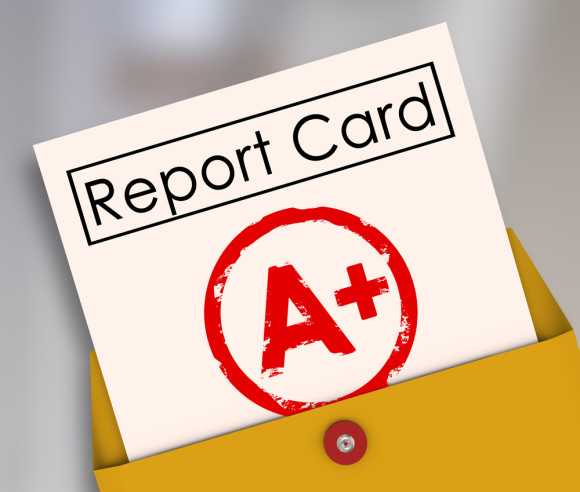Vermont gets a grade of “A+” and California and North Carolina get grades of “F” in the annual report card on state insurance regulation issued by the free market think tank, The R Street Institute.
The 2014 Insurance Regulation Report Card judges how well states do regulating the business of insurance by assigning scores in 12 different areas that include insurer solvency, pricing flexibility, competitiveness and efficiency.
“Reviewing the data on insurance in 2014, we see mostly stable trends in consumer and business freedom in state insurance markets,” said R Street Editor-in-Chief and Senior Fellow R.J. Lehmann, the author of the study, in a release. “In some states — notably Florida — real efforts were made to scale back, or otherwise place on more sound financial footing, residual insurance markets and state-run insurance entities. Other states, notably North Carolina, appear to be moving in the wrong direction.”
R Street bills itself as a think tank dedicated to free markets. Its approach to its research on regulation is to measure states’ regulatory systems against principles of “limited, effective and efficient” government.
12 Categories
The authors looked at 12 broad performance categories in grading the states: how well they monitor insurer solvency; how they police fraud; their response to consumer complaints; how efficiently they spend the insurance taxes and fees they collect; how competitive their home, auto and workers’ comp insurance markets are; to what degree they permit insurers to adjust rates and employ rating criteria as they see fit; the extent of transparency and politicization of insurance regulation in the state; and their willingness to take part in “cutting-edge regulatory modernization” initiatives.
R Street awarded Vermont consistent scores across almost all areas of the scorecard, specifically in consumer protection, politicization, auto and homeowners insurance environments, rate freedom and clarity and regulatory restrictions.
North Carolina, on the other hand, received a failing grade in part due to the state’s “inflexible rate bureau system” and recent growth of the residual market FAIR Plan and Beach Plan.
State Grades
The states receiving the best grades are: Vermont (A+), Virginia (A), Illinois (A), Iowa (A), Maine (A-), Utah (A-), Ohio (A-) and Kentucky (A-).
Twelve states received a “D” or “F” grade: California (F), North Carolina (F), Montana (D-), Hawaii (D), New York (D), Massachusetts (D), Michigan (D), Louisiana (D), Washington (D+), Mississippi (D+) and Florida (D+).
Twenty states received B+, B or B- scores: Idaho, New Jersey, Minnesota, Indiana, Nebraska Wisconsin, Colorado, Nevada, Wyoming, Kansas, Oregon, Arizona, Missouri, Tennessee, New Mexico, Rhode Island Pennsylvania, New Hampshire, Connecticut and Texas.
Eleven are graded C+, C or C-: South Dakota, Alabama, Alaska, South Carolina, North Dakota, Arkansas, Maryland, Georgia, West Virginia, Oklahoma and Delaware.
The authors state that the report is “not intended as a referendum on specific regulators” and that an “F” score does not mean that a state’s insurance commissioner is inadequate anymore than an “A+” is an endorsement of an insurance department. They note that state legislatures more than regulators often control the conditions in the most heavily weighted variables examined in their report.
On balance, the authors conclude, states do an effective job encouraging competition and ensuring solvency. On the downside, they find that “the thicket of state-by-state regulations” leads to inefficiencies and that rate controls in some states discourage capital formation, stifle competition and concentrate risk.
Among the factors the authors analyzed is how a state uses the resources it has. According to the report, states continue to draw more in regulatory fees and assessments than they spend on insurance regulation. The 50 states, Puerto Rico and the District of Columbia spent $1.32 billion on insurance regulation in 2013 but collected more than double that amount, $2.74 billion, in regulatory fees and assessments from the insurance industry.
“These surplus regulatory fees and assessments end up in state coffers to patch other holes in state budgets,” Lehmann said. “They serve as a hidden tax on insurance consumers, raising the cost of coverage for everyone.”
If premium taxes, fines and other revenues are included in the tally, only 6.4 percent of the $20.45 billion states collected from the insurance industry last year was spent on insurance regulation, down from 6.6 percent the prior year, the report says.
Members of The R Street Institute also author the RightStreet blog on InsuranceJournal.com.
Topics Legislation North Carolina
Was this article valuable?
Here are more articles you may enjoy.



 AIG’s Zaffino to Step Down as CEO as Aon’s Andersen Steps In
AIG’s Zaffino to Step Down as CEO as Aon’s Andersen Steps In  Cloudy Future for Bourbon Has Jim Beam Closing Distillery for a Year
Cloudy Future for Bourbon Has Jim Beam Closing Distillery for a Year  Relief But Questions on Agents’ Duties to Insureds After Florida Court Ruling
Relief But Questions on Agents’ Duties to Insureds After Florida Court Ruling  MAPFRE Accuses AAA of Violating Long-Time Exclusive Marketing Agreement
MAPFRE Accuses AAA of Violating Long-Time Exclusive Marketing Agreement 


